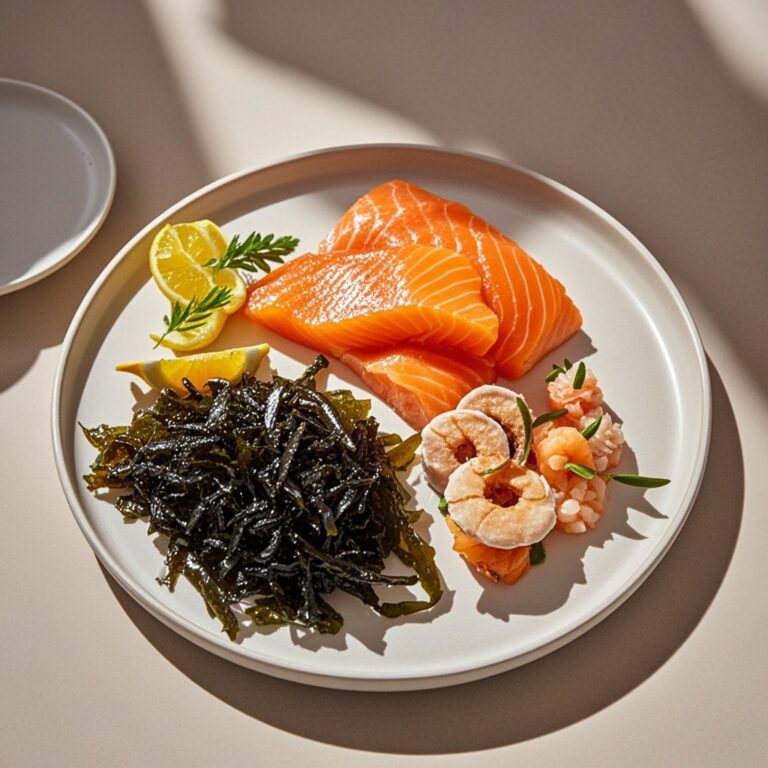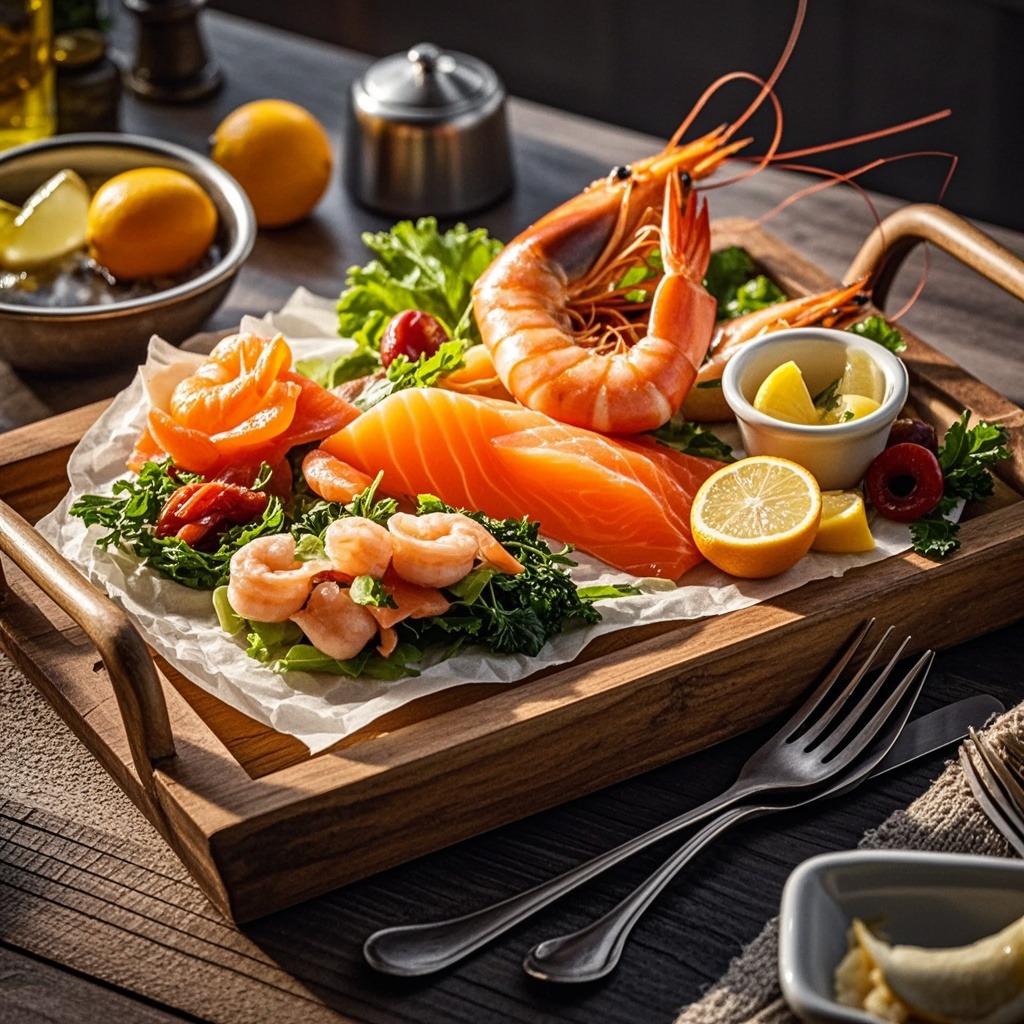
The Nordic countries—Denmark, Norway, Sweden, Finland, and Iceland—are celebrated for their deep connection to the sea and a culinary tradition that revolves around fresh, high-quality seafood. Among the standout dishes, smoked salmon holds a special place, embodying the region’s love for simple yet flavorful preparations. However, Nordic cuisine offers a diverse array of seafood dishes that reflect the culture, geography, and lifestyle of the Scandinavian people.
This article delves into the essence of Nordic seafood cuisine, exploring its iconic dishes, traditional techniques, and the cultural significance of the sea in shaping the region’s gastronomic identity.

1. The Nordic Connection to the Sea
Surrounded by icy waters and abundant marine life, the Nordic countries have a long history of fishing and seafood preservation.
- Geographical Influence: The cold, clean waters of the North Atlantic and Baltic Seas are home to some of the world’s most prized seafood, including salmon, cod, herring, and shrimp.
- Sustainability: The region is a global leader in sustainable fishing practices, ensuring the preservation of marine ecosystems for future generations.
Seafood is not just a food source—it’s a way of life. Nordic cuisine reflects the seasons, with hearty dishes in winter and lighter, fresh fare in summer.
2. Smoked Salmon: A Nordic Icon
a. Origins and Preparation
Smoked salmon is perhaps the most recognized Nordic seafood export. Traditionally, salmon was smoked to preserve it for long winters, but today, it is a delicacy enjoyed around the world.
The Smoking Process:
- Curing: The salmon is first cured with a mixture of salt, sugar, and spices.
- Smoking: The cured fish is then exposed to smoke from burning wood chips, typically alder or juniper, which imparts a rich, smoky flavor.
b. Popular Ways to Serve Smoked Salmon
- Gravlax: Cured salmon with dill, sugar, and salt, often served thinly sliced on rye bread with mustard sauce.
- Smoked Salmon with Potatoes: A quintessential Nordic pairing, often accompanied by sour cream and dill.
- Salmon Sandwiches: Open-faced sandwiches (smørrebrød in Denmark) topped with smoked salmon, cream cheese, capers, and fresh herbs.
c. Cultural Significance
In Nordic cuisine, smoked salmon is more than just a dish; it represents the ingenuity of preserving food in harsh climates while maintaining its natural flavor.
3. Other Iconic Nordic Seafood Dishes
a. Pickled Herring (Sill)
- Where: Sweden, Denmark, and Norway
- Description: Small herring fillets preserved in a tangy brine with onions, vinegar, sugar, and spices.
- How It’s Served: Often part of a traditional smorgasbord (buffet) and served with potatoes, dill, and sour cream.
- Cultural Note: Pickled herring is a festive staple during Christmas, Easter, and Midsummer celebrations.
b. Fish Soup (Fiskesuppe)
- Where: Norway
- Description: A creamy soup made with cod, haddock, or salmon, along with potatoes, carrots, and leeks.
- Why It’s Special: This hearty dish is perfect for cold Nordic winters, offering comfort and warmth.
c. Shrimp Sandwich (Räksmörgås)
- Where: Sweden
- Description: Open-faced rye bread topped with boiled shrimp, mayonnaise, lettuce, eggs, and lemon.
- Cultural Note: This dish is a favorite for lunch or light meals and highlights the simplicity of Nordic culinary traditions.
d. Icelandic Plokkfiskur (Fish Stew)
- Where: Iceland
- Description: A creamy stew made with boiled fish, potatoes, and onions, seasoned with salt and pepper.
- Why It’s Special: This dish is a comforting way to use leftover fish and reflects Iceland’s resourceful cooking methods.
e. Lutefisk
- Where: Norway and Sweden
- Description: Dried fish, typically cod, rehydrated with lye and then cooked.
- How It’s Served: Often accompanied by boiled potatoes, peas, and a white sauce.
- Cultural Note: Though polarizing due to its unique preparation and texture, lutefisk remains a traditional holiday dish.
4. Preservation Techniques in Nordic Cuisine
The Nordic climate necessitated the development of preservation methods to ensure a steady food supply during long winters.
- Smoking: Used for salmon, herring, and mackerel, imparting a distinctive smoky flavor.
- Pickling: Popular for preserving herring and other small fish.
- Drying and Curing: Methods like gravlax and lutefisk showcase the ingenuity of Nordic preservation techniques.
These methods not only prolonged the shelf life of seafood but also created flavors that are deeply cherished today.
5. Seafood and the Nordic Lifestyle
a. Sustainability and Freshness
Nordic people prioritize fresh, locally sourced ingredients. The seafood industry is carefully regulated to ensure sustainable practices, which resonates with the region’s deep respect for nature.
b. Hygge and Seafood Dining
The Danish concept of hygge (coziness) often extends to meals. Sharing a simple seafood dish, like smoked salmon or fish soup, embodies this sense of warmth and togetherness.
6. Modern Takes on Nordic Seafood
Contemporary Nordic chefs are reimagining traditional dishes while staying true to their roots.
- Fusion Dishes: Combining Nordic seafood with global cuisines, such as sushi rolls made with smoked salmon and dill.
- Fine Dining: Restaurants like Noma in Copenhagen elevate seafood into artful creations, showcasing local, seasonal ingredients.
7. Nordic Seafood Festivals and Traditions
Visiting Nordic countries during seafood festivals offers a unique cultural experience.
- Stockholm Herring Festival (Sweden): A celebration of the beloved pickled herring.
- Lofoten Cod Festival (Norway): Honors the region’s cod fishing heritage with cooking demonstrations and tastings.
- Baltic Sea Food Festival (Denmark): Features fresh seafood dishes, local wines, and coastal views.

8. Bringing Nordic Seafood to Your Kitchen
Recreating Nordic seafood dishes at home is simpler than you might think.
- Smoked Salmon Platter: Arrange smoked salmon with capers, dill, rye bread, and a dollop of sour cream for an authentic experience.
- Pickled Herring: Purchase ready-made pickled herring and serve it with boiled potatoes and sour cream.
- Fish Soup: Use fresh salmon or cod, vegetables, and cream to make a comforting Nordic-style soup.
Conclusion
Nordic cuisine, with its emphasis on fresh, sustainable seafood, reflects the region’s harmony with nature and its rich culinary traditions. Smoked salmon may be the star, but the diverse array of dishes—from pickled herring to creamy fish soup—offers a taste of Scandinavia’s unique flavors.
Exploring Nordic seafood is not just about the food; it’s about experiencing a culture that values simplicity, sustainability, and a profound connection to the sea. Whether dining on a shrimp sandwich by the Swedish coast or preparing gravlax at home, Nordic cuisine invites you to savor the best of the ocean. Skål! 🌊
Table of Contents
MORE RECIPES
The Best Stuffing Recipe for Any Occasion
- SIMPLUSPLATE.COM